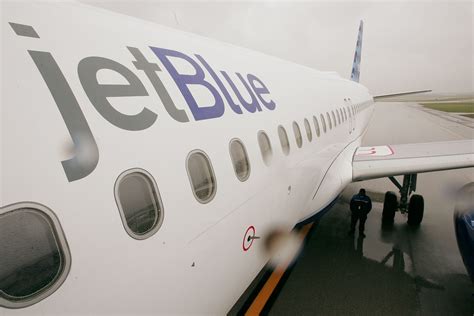
A JetBlue flight veered off the taxiway and onto the grass at Boston Logan International Airport on Wednesday night after the pilot reported a steering malfunction. No injuries were reported among the 159 passengers and six crew members aboard the Airbus A320, which had arrived from Bridgetown, Barbados.
JetBlue Plane Rolls onto Grass at Boston Logan Airport; Steering Issue Cited
BOSTON – A JetBlue aircraft carrying 159 passengers and six crew members rolled onto the grass at Boston Logan International Airport (BOS) on Wednesday evening following a reported steering failure. The Airbus A320, flight number B6203, had just arrived from Bridgetown, Barbados (BGI), when the incident occurred while taxiing to the gate.
According to Massport, the agency that operates Logan Airport, the incident occurred at approximately 8:17 PM. “Upon arrival, while taxiing, JetBlue flight 203 from Bridgetown, Barbados, exited the taxiway and entered a grassy area,” Massport said in a statement released shortly after the event.
JetBlue confirmed the incident and the reported cause. “JetBlue flight 203 from Bridgetown, Barbados, arriving at Boston Logan International Airport (BOS) tonight, exited a taxiway after landing due to a reported steering issue,” the airline stated. “No injuries were reported. Customers have deplaned and were bused to the terminal. The aircraft will be inspected.”
The aircraft came to a stop on a patch of grass adjacent to the taxiway. Emergency vehicles responded to the scene as a precautionary measure, but were quickly cleared after it was confirmed that no one was injured and there was no fire or fuel leak. Passengers were deplaned via mobile stairs and transported to the terminal by bus.
The Federal Aviation Administration (FAA) has been notified and will conduct an investigation into the incident. The focus of the investigation will likely be on the aircraft’s steering system and any potential mechanical failures that may have contributed to the incident. Investigators will also review pilot procedures and air traffic control communications.
Passengers’ Experience
Passengers aboard the flight described a jarring experience as the plane veered off the taxiway. While there was no sudden impact, the abrupt change in direction and the feeling of rolling onto uneven terrain caused concern among those on board.
“It was a little unnerving,” said one passenger, who asked not to be identified. “We could feel the plane turn sharply, and then we were bumping along on the grass. Everyone was wondering what was going on.”
Another passenger recounted, “The pilot came on the intercom and said there was a steering problem. He assured us that everything was under control, but it was still a tense few minutes until we came to a complete stop.”
The deplaning process was reported to be orderly and efficient. Passengers praised the JetBlue crew for their professionalism and calm demeanor during the situation. “The crew did a great job of keeping us informed and making sure everyone was safe,” said one passenger. “They handled a potentially scary situation very well.”
Impact on Airport Operations
The incident caused minor disruptions to operations at Logan Airport. Taxiway access was temporarily restricted while the disabled aircraft was being assessed. However, airport officials stated that the impact on overall flight schedules was minimal.
“There were some minor delays as a result of the incident, but we were able to reroute traffic and keep things moving,” said a Massport spokesperson. “The safety of our passengers and personnel is always our top priority, and we are grateful that no one was injured in this incident.”
The disabled Airbus A320 was eventually towed from the grassy area and taken to a maintenance facility for inspection and repairs. The aircraft is expected to be out of service for several days while the steering system is thoroughly examined and any necessary repairs are completed.
Airbus A320 Steering Systems
The Airbus A320 family of aircraft utilizes a complex fly-by-wire system for flight control, including steering on the ground. The nose wheel steering is controlled by the pilots using either rudder pedals or a handwheel located in the cockpit. These inputs are transmitted electronically to the nose wheel steering control unit, which then actuates hydraulic systems to turn the nose wheel.
The A320 also incorporates various safety features to prevent steering malfunctions. These include redundant hydraulic systems, backup control mechanisms, and warning systems that alert the pilots to any potential problems. Despite these safety measures, mechanical failures can still occur, as evidenced by the incident at Logan Airport.
Steering failures on aircraft can be caused by a variety of factors, including hydraulic leaks, mechanical wear, electrical faults, and software glitches. Regular maintenance and inspections are essential to detect and address potential problems before they lead to incidents.
Previous Incidents and Safety Regulations
While incidents involving aircraft veering off taxiways are relatively rare, they do occur from time to time. In many cases, these incidents are attributed to human error, such as misjudgment of speed or distance. However, mechanical failures can also play a role, as was the case in the JetBlue incident.
A number of organizations are responsible for ensuring the safety of air travel, including the FAA, the National Transportation Safety Board (NTSB), and international aviation authorities. These organizations set standards for aircraft design, maintenance, and operation, and they investigate accidents and incidents to identify causes and recommend safety improvements.
The FAA has strict regulations governing the maintenance and inspection of aircraft steering systems. Airlines are required to perform regular checks and inspections to ensure that all components are in good working order. Any identified defects must be repaired promptly.
JetBlue’s Safety Record
JetBlue has a generally good safety record. Since its founding in 1998, the airline has not experienced any fatal accidents. The airline has invested heavily in safety training and equipment, and it has a strong safety culture.
However, like all airlines, JetBlue has experienced its share of minor incidents and accidents. These incidents are thoroughly investigated, and any necessary corrective actions are taken to prevent similar incidents from occurring in the future.
The Importance of Thorough Investigation
The investigation into the JetBlue incident at Logan Airport will be crucial to determining the root cause of the steering failure and preventing similar incidents from happening in the future. Investigators will examine the aircraft’s maintenance records, interview the flight crew, and analyze data from the flight data recorder and cockpit voice recorder.
The investigation will also consider any relevant factors, such as weather conditions, runway conditions, and air traffic control procedures. The findings of the investigation will be used to make recommendations for safety improvements, which could include changes to aircraft design, maintenance procedures, or pilot training.
The FAA will use the results of the investigation to determine if any regulatory changes are necessary to improve aviation safety. The agency has the authority to issue airworthiness directives, which require airlines to make specific changes to their aircraft or operating procedures.
Wider Implications for Aviation Safety
The JetBlue incident serves as a reminder of the importance of vigilance and continuous improvement in aviation safety. Even with advanced technology and rigorous safety regulations, unforeseen events can still occur. It is essential that airlines, regulators, and manufacturers work together to identify potential risks and implement measures to mitigate them.
The incident also highlights the importance of pilot training and preparedness. Pilots must be trained to handle a wide range of emergencies, including steering failures, and they must be able to make quick decisions in stressful situations.
In addition, the incident underscores the need for effective communication between pilots, air traffic controllers, and maintenance personnel. Clear and concise communication is essential for ensuring that potential problems are identified and addressed promptly.
The Future of Aviation Safety
The aviation industry is constantly evolving, with new technologies and procedures being developed to improve safety. These include advanced flight control systems, enhanced weather forecasting tools, and more sophisticated air traffic control systems.
Automation is playing an increasingly important role in aviation safety. Automated systems can help to reduce pilot workload and prevent human errors. However, it is important to ensure that pilots are properly trained to use these systems and that they understand their limitations.
Data analysis is also becoming an increasingly important tool for improving aviation safety. By analyzing data from flight data recorders and other sources, it is possible to identify trends and patterns that could indicate potential safety problems.
The aviation industry is committed to continuous improvement in safety, and it is constantly working to reduce the risk of accidents and incidents. The JetBlue incident at Logan Airport will undoubtedly serve as a valuable learning experience, and it will help to inform future safety efforts.
JetBlue Statement in Full:
“JetBlue flight 203 from Bridgetown, Barbados, arriving at Boston Logan International Airport (BOS) tonight, exited a taxiway after landing due to a reported steering issue. No injuries were reported. Customers have deplaned and were bused to the terminal. The aircraft will be inspected. Safety is always our top priority.”
Massport Statement in Full:
“Upon arrival, while taxiing, JetBlue flight 203 from Bridgetown, Barbados, exited the taxiway and entered a grassy area.”
FAQ
1. What happened with the JetBlue flight at Boston Logan Airport?
A JetBlue flight, B6203, an Airbus A320 arriving from Bridgetown, Barbados, veered off the taxiway and onto the grass at Boston Logan International Airport on Wednesday evening. This occurred while the plane was taxiing to the gate after landing. The pilot reported a steering malfunction as the cause.
2. Were there any injuries reported in the incident?
No, there were no injuries reported among the 159 passengers and six crew members on board. This was confirmed by both JetBlue and Massport.
3. What was the cause of the JetBlue plane going onto the grass?
According to JetBlue, the cause was a “reported steering issue.” The airline stated that the plane “exited a taxiway after landing due to a reported steering issue.” The investigation by the FAA will delve deeper into the specifics of this malfunction.
4. What impact did this incident have on operations at Boston Logan Airport?
The incident caused minor disruptions to operations at Logan Airport. Taxiway access was temporarily restricted while the disabled aircraft was being assessed. However, airport officials stated that the impact on overall flight schedules was minimal. Traffic was rerouted to keep flights moving.
5. What happens next in terms of investigation and aircraft repair?
The Federal Aviation Administration (FAA) has been notified and will conduct an investigation into the incident. The focus will be on the aircraft’s steering system and any potential mechanical failures. The aircraft will be inspected and repaired, which is expected to take several days, keeping it out of service during this period. It was towed to a maintenance facility for this purpose.









